Chapter
Five Part Six
| The Stevens brothers were not so quick to adopt the new
saddle tanks as some makers, however whilst no doubt some
riders did not care for the bulbous saddle tanks it would
seem the majority did. At A.J.S. some hectic work had been
undertaken to get the new designs out and the result was a
very attractive range of machines. The new tanks were
finished in black with purple panes, and the redesigned
frames had a single top tube. Centre spring forks were
adopted and the engine was cleaned up with two port heads. A
couple of interesting machines were under development, a
straight four and a transverse 'V' twin. |
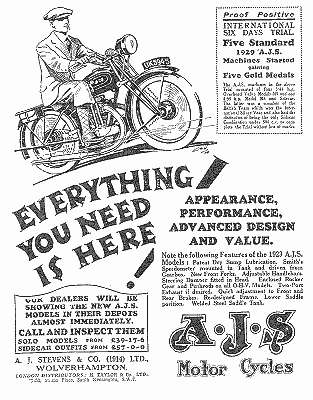 |
Returning to the competition side of motorcycling we can
report that A.J.S. continued to do very well and captured
many speed records. For the 1929 Junior T.T. on the Isle of
Man A.J.S. obtained the services of the great Walter
Handley. Frank Longman returned to the Graiseley team and
with George Rowley they made a formidable trio. Sunbeam also
had a fine team consisting of Charlie Dodson, Arthur Simcock,
Francisco Franconi, and Gilbert Emery, who had done so well
in the Amateur T.T. Whilst many experts favoured a Sunbeam
victory, no one could discount the ohc Velocettes, and with
riders of the calibre of Freddie Hicks and Alec Bennett they
were in with a very good chance. The race took place in
excellent weather conditions and the Velocettes dominated
proceedings with Handley giving them some stiff opposition. |
| Sunbeam was also very competitive, but the race fell to
Freddie Hicks who completed the race on his Velocette in 3
hours 47 minutes 23 seconds at an average speed of
69.11m.p.h. He also set the fastest lap at 70.95m.p.h., in
both cases Junior records. 2nd place went to Wal Handley who
brought his A.J.S. home just l minute 22 seconds behind the
winner. 3rd spot was filled by Alec Bennett with Charlie
Dodson finishing 4th on his Sunbeam. Other Sunbeams took
12th and 14th places, and an A.J.S finished 15th.
Excellent conditions also attended the Senior race and some
good racing was looked forward to by the large crowds around
the course. Sunbeams were very much the favourites to do it
again, though the Rudges were known to be very strong
challengers and in no way could Norton be forgotten with
jockeys Stanley Woods and Tim Hunt. The enthusiasts could
see it would be a very open race and awaited the outcome
with some excitement. Tyrell Smith took an early lead on the
Rudge with Tim Hunt and Charlie Dodson in 2nd and 3rd
places. This continued and by lap 4 Tyrell Smith had an
advantage of more than 3 minutes over Hunt with Dodson a
strong 3rd. Things soon changed when the Rudge teamster
crashed heavily at Glen Helen to put Hunt on the Norton into
the lead. Alec Bennett who had returned to the Marston fold
was also going very well and catching up on Dodson in 3rd
place. Problems began with the Norton and little Charlie
went into first place with team mate Bennett second. Much
interest now focussed on Tyrell Smith for he had got home
again after his crash and was now really motoring. |
| Charlie Dodson went on to win his 2nd Senior T.T. with
team mate Alec Bennett in 2nd place, over 4 minutes down.
The gallant Tyrell Smith brought his Rudge into 3rd place,
only 50 seconds behind Bennett. When Tyrell Smith was
examined at the finish it was found that as well as
extensive leg injuries he had also suffered three cracked
ribs in his accident at Glen Helen, so his was a really
wonderful performance, riders were really tough in those
days.
Whilst no doubt for his crash, the Rudge man could well
have won the Coventry concerns first Senior since 1914,
however it was the Sunbeam that won. |
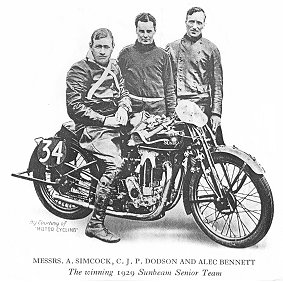 |
| Dodson's time for the race was 3 hours 39 minutes 59
seconds, an average speed of 72.05m.p.h., a record, as was
his fastest lap in 30 minutes 47seconds. An average speed of
73. 55m.p.h. With Dodson winning and Alec Bennett 2nd the
3rd member of the team Arthur Simcock's took 7th place and
this brought Sunbeam the Manufacturers Team Prize for the
third year in succession. Another Sunbeam finished in 11th
place and the only A.J.S. to complete the race, ridden by
Frank Longman came 16th.
There was much rejoicing in Wolverhampton at the great
Sunbeam victory and the Express & Star devoted three full
columns of the then large format paper with a whole eight
column headline. |
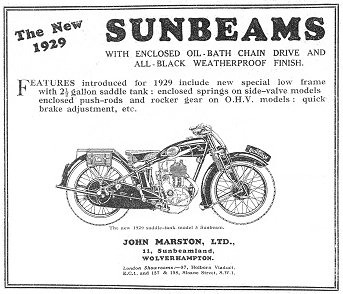 |
The Secretary of the John Marston Company let it be
known how these racing successes helped sales of machines
and rightly pointed out how prestige was brought to the
country, and also to the town when the winning machine was
made in Wolverhampton. Later a testimonial dinner was
given to Charlie Dodson with managing director, A.S. Bowers
presiding. The 1929 Senior T.T. had been great for Sunbeam.
All enthusiasts hoped they would continue to do well and
that A.J.S. would soon return to their T.T. winning ways. |
Before the T.T. races, which were held in June, A.J.S.
had attracted a lot of attention when they went in for a
spot of record breaking at Brooklands. Many records were
taken by riders Bert Denley and Leo Davenport including
seven 350c.c. sidecar world records ranging from the 4 hours
at 66.08m.p.h. to the 8 hours at 65.65m.p.h. All told at
this time A.J.S. held no less than 117 world speed records,
most of them gained by Bert Denley or Charlie Hough. Of
course both Davenport and Hough were well known A.J.S. men,
but Denley had been a very successful Norton rider of Nigel
Spring's machines. Spring had now decided to change to
A.J.S. and so Bert Denley was seen astride the Wolverhampton
machines. This combination would gain many successes on the
track.
As we have mentioned above, enthusiasts were looking for
A.J.S. success in the Isle of Man but we must not loose
sight of the fact that although the T.T. was the most famous
of races many classic races also took place on the
continent. It was here that A.J.S. as well as Sunbeam
excelled. George Rowley won the Austrian Grand Prix on his
A.J.S. and Arthur Simcock, now riding the rival
Wolverhampton marque won the 500c.c. race.
The Spanish 350c.c. Grand Prix was won by Leo Davenport on
an A.J.S. while the 500c.c. class in the French and Belgian
Grand Prix were won at an average speed of over 80m.p.h. by
Charlie Dodson riding Sunbeams. During the year Sunbeams in
the hands of local riders also won the 1,000c.c. Grand Prix
in Germany and also the Hungarian Grand Prix. In Italy at
the famous Monza track Achillie Varzi won the 500c.c. Grand
Prix des Nations on a Sunbeam at an average speed of
85.49m.p.h. also setting the fastest lap at 94.49m.p.h. This
was a fine effort, as due to the small tank fitted to his
machine, he had needed to stop for fuel five times. Achillie
Varzi would of course become famous as a great car driver
and at the same time as his success mentioned above, he also
won the Monza Grand Prix for cars, driving an Alfa Romeo at
an average speed of 116m.p.h. |
Now to return nearer home and the Ulster Grand Prix. The
500c.c. race was dominated by Rudge and Norton riders which
resulted in a win for Graham Walker on a Rudge with the
Nortons of Tim Hunt and Stanley Woods 2nd and 3rd. The 350
race had been extended by one lap to a distance of 225.5
miles. From the start Joe Craig set a cracking pace on his
Norton, setting a new lap record in the process. He was soon
sidelined however with mechanical trouble, and this proved
to be his last race. Joe of course went on to become racing
chief at Nortons and in the 1950s was architect of their
very many victories around the world.
To return to the race, Leo Davenport riding very fast took
the lead and went through
to win on his A.J.S. with a time of 2 hours 57 minutes 29
seconds, an average of 76.23m.p.h. Team mate George Rowley
took 2nd place, 3 minutes 46seconds behind the winner. |
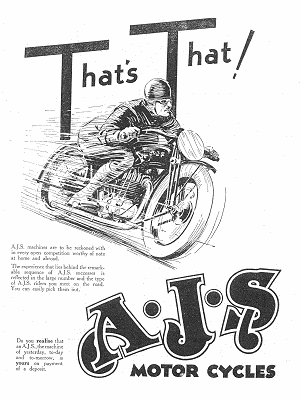 |
| A.J.S. had won their first Ulster Grand Prix and for the
second time were runners up. We now return to the Isle of
Man for the 1929 Amateur T.T. and to a by no means pleasing
atmosphere. During the period since the previous year's race
there had been a lot of ill feeling caused by certain riders
being thought to have accepted unauthorised financial and
material help. Despite the unpleasant undercurrent, obvious
to many, two very good races seemed to be in prospect with
an excellent entry for both.
Of the 34 entries for the Junior race, 4 would be riding
Sunbeams and 3 A.J.S. Favourite to win was W. Meageen on his
Rex Acme, although many also favoured a win by a Velocette
rider. It seemed from the start that the later was correct
for J. Hanson went off at a cracking pace aboard his Velo
and took 1.5 minutes off the lap record from a standing
start. Other Hall Green machines filled the next 4 places
with Meageen down in 6th spot. On lap 5 the Manxman really
turn the wick up on the Rex putting in a lap at 67.8m.p.h.,
which would prove to be the days' fastest. He now dead
heated for 2nd place with A.S. Sikes and now came the drama.
The leader Hanson had engine trouble and Meageen took the
lead, then on the last lap the Rex's throttle cable came
adrift, Meageen kept going, but at the very tricky Govenors
Bridge, and almost within sight of the chequered flag the
Manxman stalled the engine. Try as he would he could not
restart it and started to push in. Such was his lead that he
crossed the line to win by 12 seconds from E.N. Lea's
Velocette with D.Z. de Ferranti of the famous electrical
manufacturing concern in 3rd place, riding a New Henley. Now
came a sensational decision. A protest against Meageen was
laid saying that he had received outside assistance at
Govenors Bridge and he was disqualified. This put Lea into
first place and Ferranti second. |
|
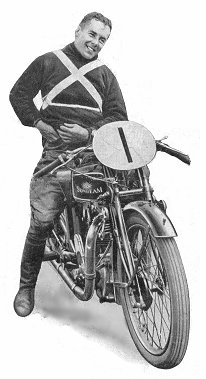
Charlie Dodson on a Sunbeam. |
Riders of Wolverhampton machines had not really figured
in the race, however R. Allen finished 6th on a Sunbeam
while W.G. Bevan and G.H. Lennie were 8th and 9th on AJs.
One rider of an A.J.S. retired as did one who had chosen
Sunbeam. Two second Sunbeam riders were disqualified. To sum
up, the 1929 Junior Amateur T.T. had been a fast and
exciting race but marred by protests leading to
disqualifications. Happily the Senior would not suffer
these problems, well not immediately, though events would
follow that would bring the Amateur T.T. to an end.
Briefly, J.D. Potts riding a Grindlay Peerles won at an
average speed of 66.25m.p.h. with E.N. Lea second on a
Norton. The fastest lap fell to H.J. Bacon who took his
Sunbeam round in 32 minutes 21 seconds, just short of the
first Junior over 70 lap at 69.99m.p.h. whilst S. Lees and
G. Rea were 6th and 7th on their Sunbeams. Two other Sunbeam
riders were disqualified and none of the A.J.S. riders
completed the course. |
Whilst there had been no official protests there had
been murmurings and a later an ACU enquiry which led to the
disqualification of the winner J .D. Potts. This of course
made Lea the winner, so he had won both Junior and Senior
Amateur T.T.s but on each occasion after a protest, a far
from happy situation. Lea however was in no way to blame for
he had not lodged the protest. The enquiry also recommended
the suspension of 21 riders and excluded them from any
awards won in the 1929 Amateur races, although the results
of the Junior were not effected. All this took many months
and it was at the end of 1929 before the matter was cleared
up. This was to bring the Amateur T.T. races to an end,
however a new race would take its place and happily has
continued to the present time.
It has been mentioned earlier that reliability trials played
a big part in most manufacturer's competition programmes.
Whilst lacking the glamour of racing trials, the reliability
trials greatly helped to prove the product and success in
that field brought a boost to sales.
Important as trials were it would be quite impossible to do
them justice in this present story and we have been able to
only take very brief notice of them. Before closing the
present chapter though a look at the 1929 Scottish Six Days
Trial which had been held in May and would be the only six
days event held in Britain that year. There were a good
number of riders astride A.J.S. and Sunbeams including a
works team from each factory, and they did well. A.J.S. won
the 350c.c. Manufacturer's Team Prize and Sunbeam the
Unlimited Manufacturer's Team Prize. The trial, which
started from Edinburgh had some very tough sections, and
riders had to cover a total distance of 1,006 miles with 195
miles being the longest distance covered on a single day.
The A.J.S. team consisted of George Rowley, Leo Davenport
and Clarrie Wise, all of whom won silver cups. Private entry
A. Downie won a bronze medal after failing some sections and
suffering from tyre troubles. Each member of the Sunbeam
team consisting of Vic Brittain, D.Q. Archer Bates, and Drew
McQueen won a silver cup. Sunbeam riders J. Grout and James
Beck Jnr on 347c.c. machines also gained silver cups as did
Stan Higson and sidecar expert N.P.O. Bradley. This was a
very fine result for the two Wolverhampton concerns. |
It is interesting to read comments on the individual
riders that were published in "MotorCycling" magazine. The
remarks on George Rowley included "magnificent rider,
probably the most spectacular man in the trial and certainly
the most popular with the spectators".
As we have seen George was a great all rounder, being a very
good road racing man who excelled at trials as well as
motorcycle football, a very popular sport at one time.The
remarks on the two other AJ men included Clarrie Wise,
"sometimes rather wild but always able to get there". Leo
Davenport is described as "a steady and determined rider,
unruffled by emergencies and not afraid to foot when
necessary". Leo of course was also an excellent road racer
and his father Tom Davenport held a managerial post at the
Graiseley Works. |
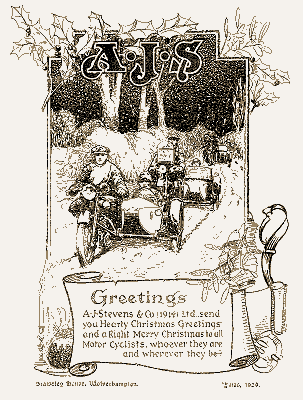 |
|
Of the Sunbeam team the best known rider must be Vic Brittain,
one of the all time greats of the trials world. In the 1950s his
son John would become a leading trials ace. The "MotorCycling"
report said that "Vic never went wrong, and as usual kept his
feet up throughout"
Drew McQueen who was also a dirt track rider received the
comment that "feet up and flat out were his watchwords" and
Archer Bates was described as "fast, steady and feet up". There
was much praise for the performance of private rider, schoolboy,
James Beck Jnr. The report mentioned his outstanding ability and
suggested that he would rank with the star men.
And so we bring to an end to this chapter. We have seen many
successes for the Wolverhampton motor firms and also failures.
Unfortunately the following chapter will have to record more bad
times than good. |
 |
|
 |
Return to
Part 5 |
|
Return to
the beginning |
|